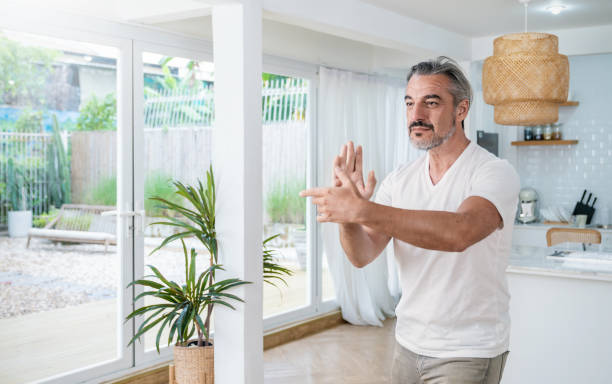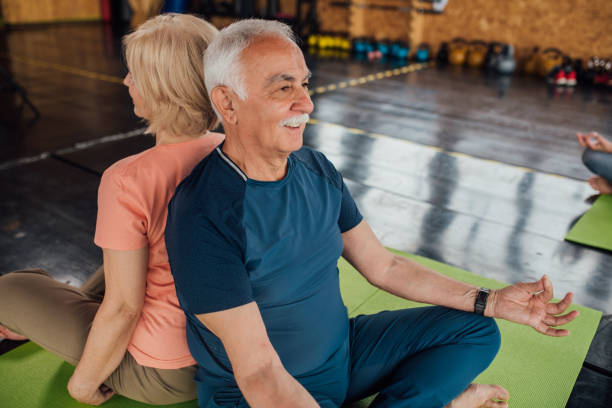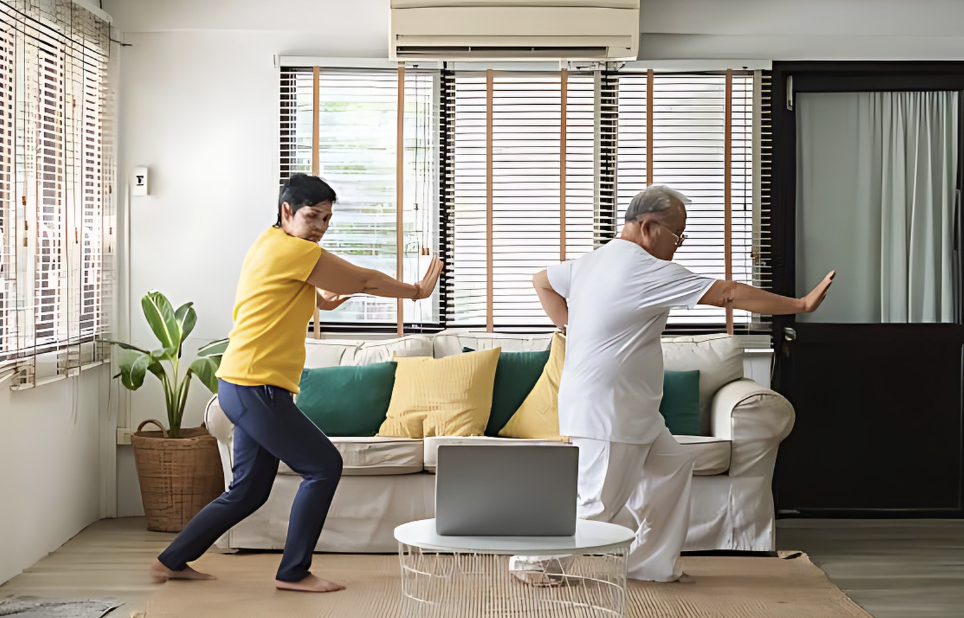Body movement Therapy
Learn Tai Chi from the Comfort of Your Home
Are you interested in tai chi but find it difficult to attend a class? Well, you are in luck! In this article, we will look at how to practice tai chi at home, allowing you to get the myriad health advantages of this ancient Chinese martial art right in the comfort of your own home.
Whether you’re a novice or have some expertise with tai chi, we’ll provide you step-by-step instructions and helpful ideas so you can practice efficiently on your own. From locating the correct resources and setting a tranquil environment to mastering the fundamentals and graduating to more sophisticated routines. With consistent practice, you can enhance your balance, flexibility, and overall health. So, roll out your mat, turn on some relaxing music, and prepare to start on a journey of self-discovery and inner serenity with tai chi at home.
Benefits of Practicing Tai Chi at Home
Practicing tai chi at home has various advantages that might improve your overall health. First and foremost, practicing tai chi at your own home allows you to personalize your practice to your individual needs and timetable. You can select the most convenient time for you and avoid commuting to class. Furthermore, training at home gives you a sense of solitude and freedom, allowing you to fully immerse yourself in the exercise without any outside interruptions. Furthermore, frequent home practice allows you to improve at your own speed while gradually increasing strength, flexibility, and balance.
Second, practicing tai chi at home can help decrease stress. The peaceful atmosphere of your own area provides a tranquil environment away from the hustle and bustle of a busy class. Dimming the lights, lighting candles or incense, and playing calming music can all help to create a relaxing atmosphere. This serene location will help you relax, reduce tension, and achieve inner peace.
Finally, practicing tai chi at home can help you save money over time. Attending lessons or hiring a personal instructor might be costly, but practicing at home eliminates these expenses. All you need is a little place, some comfortable clothes, and a desire to study. By practicing at home, you can reap the benefits of tai chi without breaking the wallet.

Getting Started with Tai Chi at Home
Before you begin practicing tai chi, you need mentally and physically prepare. Here are a few steps to get you started:
- Set your intentions: Take a time to consider why you want to practice Tai Chi at home. Setting clear aims, whether for health, stress reduction, or overall well-being, will help you stay focused and motivated.
- Create a schedule: Determine how frequently you want to practice tai chi and schedule specific time in your daily or weekly routine. Consistency is essential for obtaining the advantages of tai chi, so commit to your practice and stick to your routine.
- Find a trustworthy resource: There are numerous resources available online, including as videos, tutorials, and online classes, to help you along your tai chi journey. Look for credible sites with clear instructions and demonstrations.
- Start with the basics: If you’re new to tai chi, you should start with the fundamentals and work your way up to more complex routines. This will help you lay a solid foundation and avoid damage. As your confidence grows, you can try more sophisticated techniques.
- Be patient and persistent: Tai chi is a lifelong practice that requires time to learn the techniques and reap its full benefits. Do not get discouraged if you do not notice quick benefits. Stay devoted, be patient with yourself, and enjoy the process of self-improvement.
By following these steps, you’ll be well-prepared to begin your tai chi practice at home and reap the many rewards it offers.
Choosing the Right Space for Practicing Tai Chi
When practicing tai chi at home, it’s essential to choose a suitable space that provides enough room for movement and promotes a sense of tranquility. Here’s how to create the perfect environment for your practice:
- Clear the space: Remove any furniture or things that may be impeding your progress. You should have enough room to stretch your arms without striking anything.
- Create a peaceful atmosphere: Create a quiet mood by dimming the lights or using soft lighting. Consider using fragrant candles or incense to help you relax. Playing soft, instrumental music can also help set the tone.
- Ensure appropriate ventilation: appropriate airflow is essential during your practice. To provide adequate ventilation, open a window or utilize a fan. This will allow you to remain relaxed and focused.
- Consider a defined location: If possible, set aside a specific area in your home for Tai Chi practice. This will help to establish a sense of tradition and make it easier to stick to a consistent practice schedule.
By finding the right space and creating a peaceful environment, you’ll be able to fully immerse yourself in your tai chi practice and experience its transformative power.

Warm-up Exercises for Tai Chi at Home
Before diving into the main tai chi movements, it’s crucial to warm up your body to prevent injuries and prepare yourself for the practice. Here are some warm-up exercises you can incorporate into your routine:
- Joint rotations: Begin by gently rotating your neck, shoulders, wrists, hips, knees, and ankles. This improves mobility and warms up the joints.
- Breathing exercises: Deep breathing exercises can help enhance oxygen flow and induce calm. Take slow, deep breaths in with your nose, expanding your belly, then slowly exhale through your mouth.
- Gentle stretching: Gentle stretching exercises will help you warm up your muscles and increase your flexibility. Focus on the neck, shoulders, back, hips, and legs.
Remember to listen to your body and never push yourself beyond your limits. Warm-up exercises should be gentle and comfortable, not strenuous.
Basic Tai Chi Moves for Beginners
Now that you’re warmed up, it’s time to dive into the basic tai chi moves. These foundational movements form the building blocks of your tai chi practice. Here are a few essential moves to get you started:
- Wuji stance: Start by standing with your feet shoulder-width apart and toes pointed forward. Relax your shoulders, stretch your spine, and slightly tuck your tailbone. This is the beginning point for most tai chi motions.
- Tai Chi walk: Begin by taking a stride forward with your left foot while keeping your body relaxed and balanced. Transfer your weight to the left foot and let the right foot follow naturally. Continue to walk slowly and mindfully, matching your steps with your breathing.
- Single whip: From the Wuji stance, shift your weight to your right foot and stretch your left arm forward, palm facing down. At the same time, swivel your torso to the right and let your right hand to follow suit. This technique improves coordination and flexibility.
Remember to practice each move slowly and mindfully, focusing on your breath and maintaining proper alignment. If you’re unsure about the correct form, refer to reliable resources or consult a tai chi instructor.

Building a Tai Chi Routine for Home Practice
As you become more comfortable with the basic moves, you can start building a tai chi routine that suits your needs and goals. Here are some tips to help you create an effective home practice routine:
- Start with a warm-up: Perform the warm-up activities we described before. This will help prepare your body and mind for the tai chi practice.
- Focus on the basics: Incorporate the basic tai chi exercises that we discussed into your program. Begin with a few repetitions of each technique, gradually increasing as you go.
- Advance to more advanced moves: Once you’re comfortable with the fundamentals, you can begin introducing more complex moves and sequences into your practice. Challenge yourself to learn new movements and broaden your repertoire.
- Include relaxation and meditation: Set out a few minutes at the conclusion of your program to relax and meditate. This will help you relax and internalize the benefits of the practice.
- Practice regularly: Tai chi requires consistency, therefore practice it on a regular basis. Aim to practice three to five times per week, progressively increasing the time as you progress. Remember that even a short daily practice can provide tremendous benefits.
By following these guidelines, you can create a personalized tai chi routine that aligns with your goals and allows you to progress at your own pace.
Tips for Maintaining Motivation and Discipline in Home Tai Chi Practice
Practicing tai chi at home requires discipline and motivation. Here are some tips to help you stay committed to your practice:
- Set realistic goals: Begin with small, attainable goals, then progressively increase the intensity and duration of your practice. This will keep you motivated and prevent burnout.
- Find a practice partner: If possible, practice tai chi with a friend or family member. Having a practice partner can enhance the experience while also providing support and accountability.
- Join online communities: Connect with others who share your interests by joining online tai chi communities and forums. Share your progress, ask questions, and be inspired by others on the same path.
- Celebrate milestones: Recognize your accomplishments along the way. Recognize and praise your progress, whether it’s learning a new move or sticking to a practice schedule for a month.
- Stay curious and open-minded: Maintain an open mind and be curious about the practice. Explore other genres, attend workshops, and keep learning to expand your knowledge and keep your practice fresh.
Remember, tai chi is a lifelong journey, and there will be ups and downs along the way. Embrace the process, stay committed, and enjoy the transformative power of tai chi.

Resources for Learning Tai Chi at Home
There are numerous resources available to help you learn tai chi at home. Here are some options to consider:
- Online videos: Platforms such as YouTube provide a wide range of tai chi instructions and classes. Look for reliable channels that offer clear instructions and demos.
- Online courses: Numerous websites provide online tai chi classes taught by expert instructors. These courses frequently include scheduled instruction and allow for interaction with the lecturer and other students.
- Books and DVDs: There are numerous books and DVDs available that provide extensive instructions for tai chi practice. Look for trustworthy authors and instructors with substantial experience in tai chi.
- Local classes: If you want to learn tai chi in person, consider taking a local class. Check your local community centers, fitness studios, or martial arts schools for options.
When choosing a resource, ensure that it aligns with your goals and learning style. Experiment with different sources to find the ones that resonate with you and support your progress.
Conclusion
Practicing tai chi at home is a rewarding and convenient way to get the many advantages of this ancient Chinese martial technique. By following the techniques given in this article, you may create a quiet setting, master the fundamental moves, and develop a personalized regimen that meets your specific needs. Remember to be consistent, stay motivated, and seek out credible resources to help you along your tai chi path. With consistent practice, you’ll enhance your balance, flexibility, and overall health. So, roll out your mat, turn on some relaxing music, and enjoy the healing power of tai chi at home.
Trusted Health, Wellness, and Medical advice for your well-being


